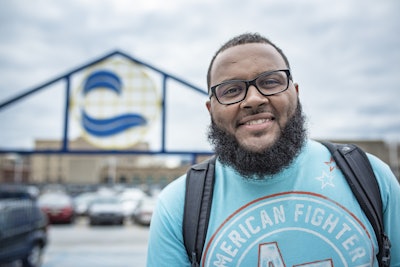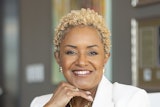Sixteen institutions are featured in Diverse’s 2020 Most Promising Places to Work in Community Colleges (MPPWCC), highlighting their focus on recruitment, hiring and retention of diverse faculty and staff as well as inclusive campus policies and initiatives.
Among this year’s schools, seven were also recognized in last year’s MPPWCC list, including the Community College of Allegheny County, Garden City Community College, Harrisburg Area Community College, Montgomery County Community College, Northeast Lakeview College, Pierpont Community and Technical College and South Seattle College.
“We are just honored to be recognized,” says Wendy Walden, associate vice president of executive affairs at Greenville Technical College. “Being recognized that we are doing something right. We will continue to offer new programs and new opportunities for people to come together more and have intentional conversations about topics and issues that are important to them.”
Dr. Bill Pink, president of Grand Rapids Community College (GRCC), says this type of recognition means that an institution is showing it is “trying, on the right track and are paying attention” to those needs on campus.
 A Grand Rapids Community College student
A Grand Rapids Community College student“I think that’s what the key is here,” he says. “Making sure that, as an institution, you’re paying attention. Because if you do not pay attention, the possibility of gaps across your campus is just so much more prevalent. Gaps in terms of people who may just not feel like they belong.”
In general, campus diversity brings both a richness in background and experience, according to Pink. He says that student demographics should be the driving factor of the school’s faculty and staff diversity.
According to GRCC’s website, in 2019, 330 of 637 faculty and staff were women and 137 were considered minority. On the other hand, 62% of students were White, 15% were Hispanic, 9% were African American and 4% were Asian.
“I want to do as much as we can to make sure our students see people in the classroom that look like they do,” says Pink. “I need them to see people that look like they do so they know that [they] can do that too.”
Recently, Pink implemented five new strategic goals for the university, one of which was equity.
To promote equity, GRCC has been engaged in a regional effort called Hire Reach. The initiative uses an evidence-based selection process and aims to take the bias out of hiring practices.
Additionally, the school’s Office of Diversity, Equity, and Inclusion (ODEI) has continued to build relationships with departments on campus including both non-academic and academic. There has also been collaboration with the ODEI and the human resources department.
Diverse on purpose
At Greenville Technical College, Walden says the school has been “intentional” about ensuring it has a diverse group of faculty and staff in order to reflect the composition of the student body.
To address appropriate workplace behavior and guidelines, the institution implemented the Civil Treatment Training program. Topics of discussions range from sexual harassment, diversity and inclusion, national origin issues, communication skills, company policies and teamwork.
“It focuses on individuals treating each other with respect, no matter your ethnic background, age or culture,” says Walden. “We just really foster that culture of inclusivity.”
In the future, Greenville will look to build on its current foundation around diversity training. The institution will require unconscious bias training. Greenville also offers non-mandatory training for employees to participate in.
“We want to make sure that all members of the organization receive the fundamental training that we think is important for them to have,” says Walden. “Because it reflects not just the president and the executive staff and how they view diversity, but it also represents how we view the community as well.”
At Garden City Community College (GCCC), Shajia Donecker, GCCC’s marketing and public relations coordinator, says the institution is in a “unique circumstance” compared to other rural community colleges.
“We live in an incredibly diverse community where multiple languages are spoken and people
come from many backgrounds,” she says. “That diversity is represented in our student body and
 Beverly Shannon, far right, teaches an English class at Grand Rapids Community College.
Beverly Shannon, far right, teaches an English class at Grand Rapids Community College.across our campus community and it is represented well through the various student-led initiatives on campus as well as [the] administration’s priorities to train and educate staff.”
One recently implemented program to address equity on campus was a socio-economic awareness training, which involved role playing for both faculty and staff members.
“The goal was to heighten awareness of the challenges of poverty and other related issues that our students and possibly other employees face in their day to day lives,” says Donecker. “It was an eye-opening experience for many of our employees and increased engagement in related initiatives on our campus.”
Winning ‘hearts and minds’
Additionally, Rose Makofske, Montgomery County Community College’s (MCCC) director of equity and diversity and Title IX coordinator said it is important to recognize that diversity and inclusion is both strategic and also “hearts and minds” work.
“It doesn’t stop at the hiring phase, it doesn’t stop at the recruitment phase, it doesn’t stop at the retention efforts,” she adds. “It begins with one person at one time in every area of the college.”
One recruitment program at MCCC is the faculty diversity fellowship. Individuals from historically underrepresented populations are actively recruited to become full-time faculty as part of a one-year fellowship program. At the end of the year, if there is a position available, the fellows are encouraged to apply.
According to Makofske, more than 20 current faculty members have been part of the fellowship program.
Additionally, one recent change made to the program is that fellows no longer have to apply for a job again. If they did well in their position, they can automatically become part of the permanent full-time faculty. The program is also now branching out to non-teaching faculty members, non-academic and those in the library.
“It’s an exciting program,” says Makofske. “You have to have faculty and scholars in positions as they serve as both role models and also have different pedagogical approaches to an increasingly diverse student body.”
 Dr. Niraj Joshi, far left, teaches an anatomy and physiology class at Grand Rapids Community College.
Dr. Niraj Joshi, far left, teaches an anatomy and physiology class at Grand Rapids Community College.Faculty members can also earn a support grant for a year if they propose a curriculum change to further focus on diversity efforts.
Additionally, MCCC recently launched an annual symposium dedicated to diversity. This year, Richard Blanco, a poet who recited at the second inauguration of former President Barack Obama, spoke.
“We have a very strong commitment to diversity and inclusion,” she says. “We have a very holistic view of what that entails as well as a commitment to the success of both students and employees in the areas of diversity, inclusion and equity.”
Lastly, after many faculty members and individuals on campus felt like the college had undergone a lot of changes, a “Coffee with a Colleague” program was implemented. Faculty have the opportunity to build better workplace relationships and learn about each other on a more personal level.
Of the institutions recognized, many understand that creating diversity, inclusion and equity practices on campus is an ongoing effort.
“You have to continue to work at it and evolve,” says Walden. “Things change from time to time, priorities change, you have to continue to work at it, be creative and innovative on things that are needed within the organization.”
This article originally appeared in the May 14, 2020 edition of Diverse. You can find it here.


















